Abstract
The electrical properties of epithelial cell membranes in human descending and ascending colon were studied using microelectrodes and the Na channel blocker amiloride. Under control (pre-amiloride) conditions, the transepithelial electrical measurements in the two colonic segments were similar. The mucosal addition of 0.1 mM amiloride to descending colon totally abolished the transepithelial voltage (Vt) and short-circuit current (Isc), and significantly increased the total tissue resistance (Rt) by 19% (p less than 0.005). Intracellular recordings in descending colon obtained with microelectrodes revealed that the transepithelial effects of amiloride reflected hyperpolarization of the apical membrane and a significant increase in apical membrane resistance, changes which were consistent with amiloride-blockade of apical Na channels and complete inhibition of electrogenic Na transport. An appreciable amiloride-insensitive conductance was also present in the apical membrane of the descending colon. In contrast, the mucosal addition of 0.1 mM amiloride to ascending colon decreased Vt by only 30% (p less than 0.02) and Isc by 43% (p less than 0.05), but had no significant effect on Rt. These results indicate that electrogenic Na transport accounts totally for Isc in human descending colon in vitro, but only partly for Isc in human ascending colon, suggesting that Na transport in ascending colon is mediated primarily by electroneutral processes, and the apical membrane of human descending colon contains an amiloride-sensitive conductance for Na in parallel with an amiloride-insensitive conductance, which may transport K.
Full text
PDF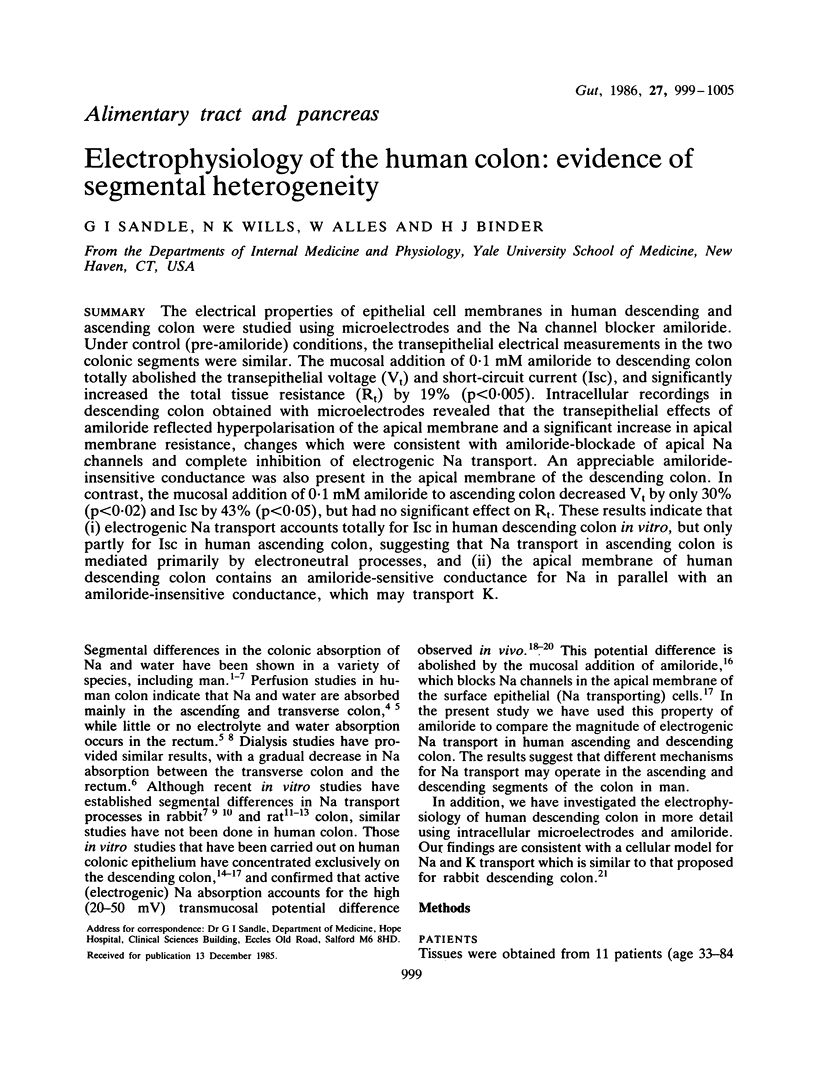
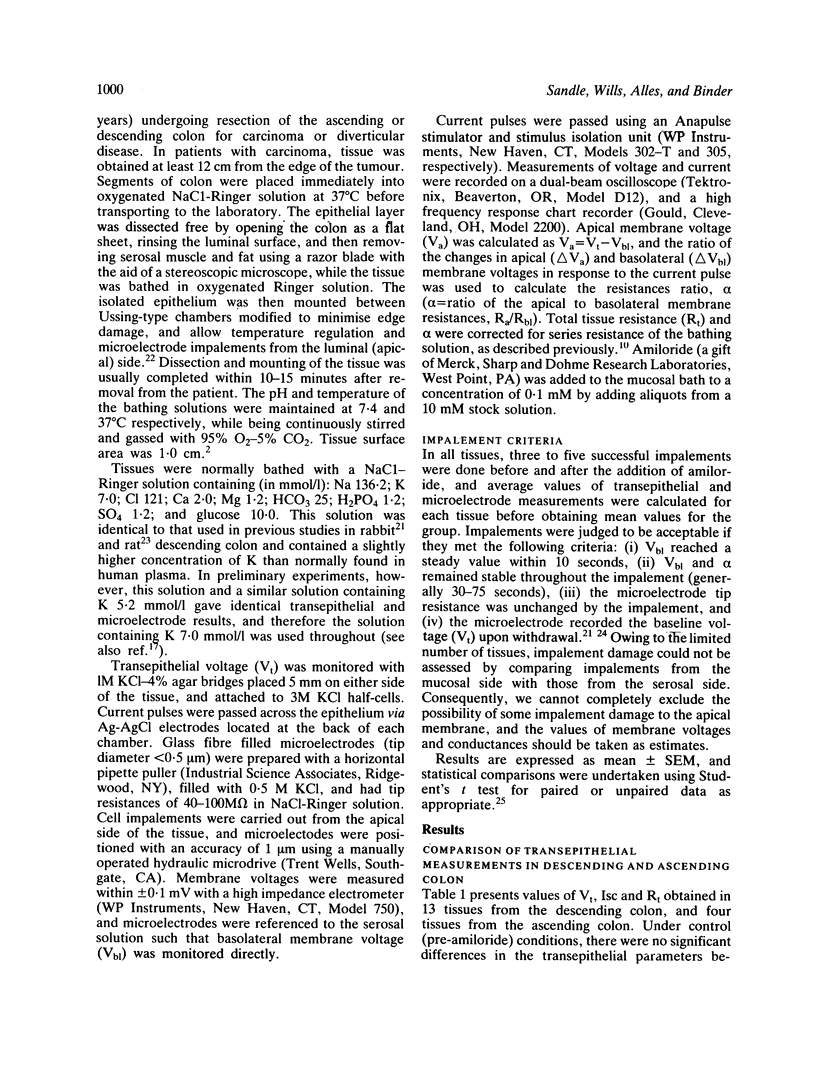

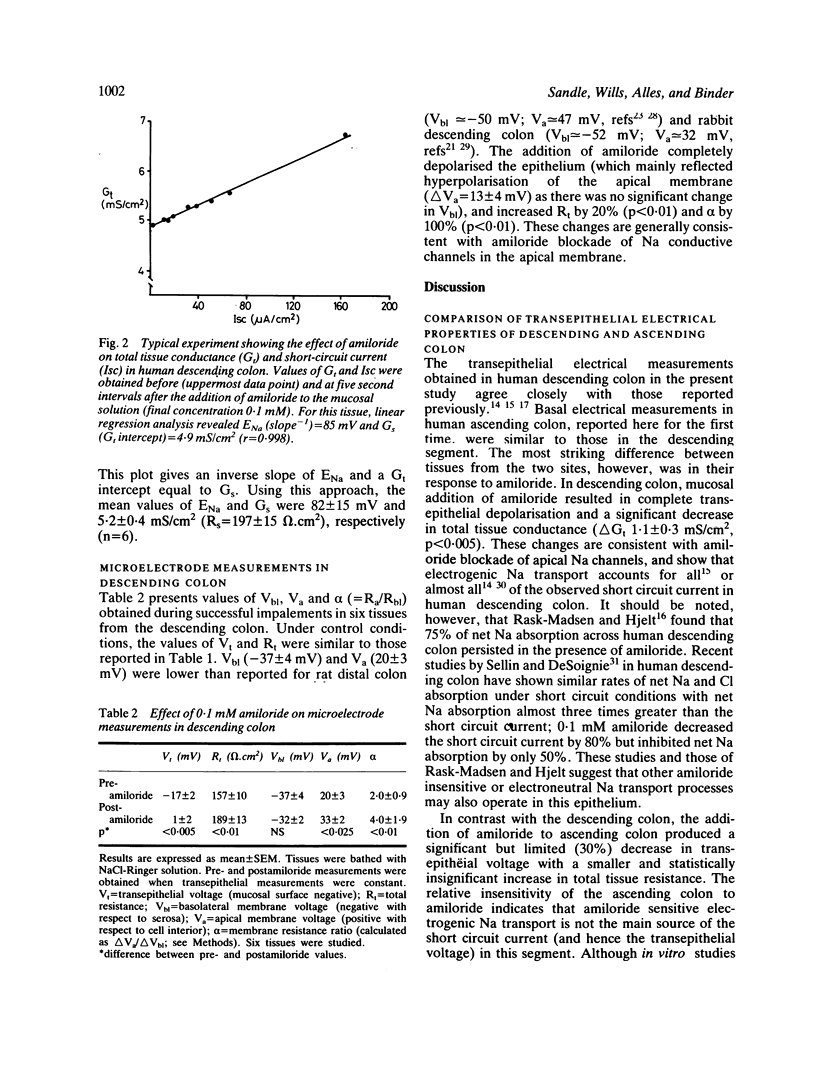
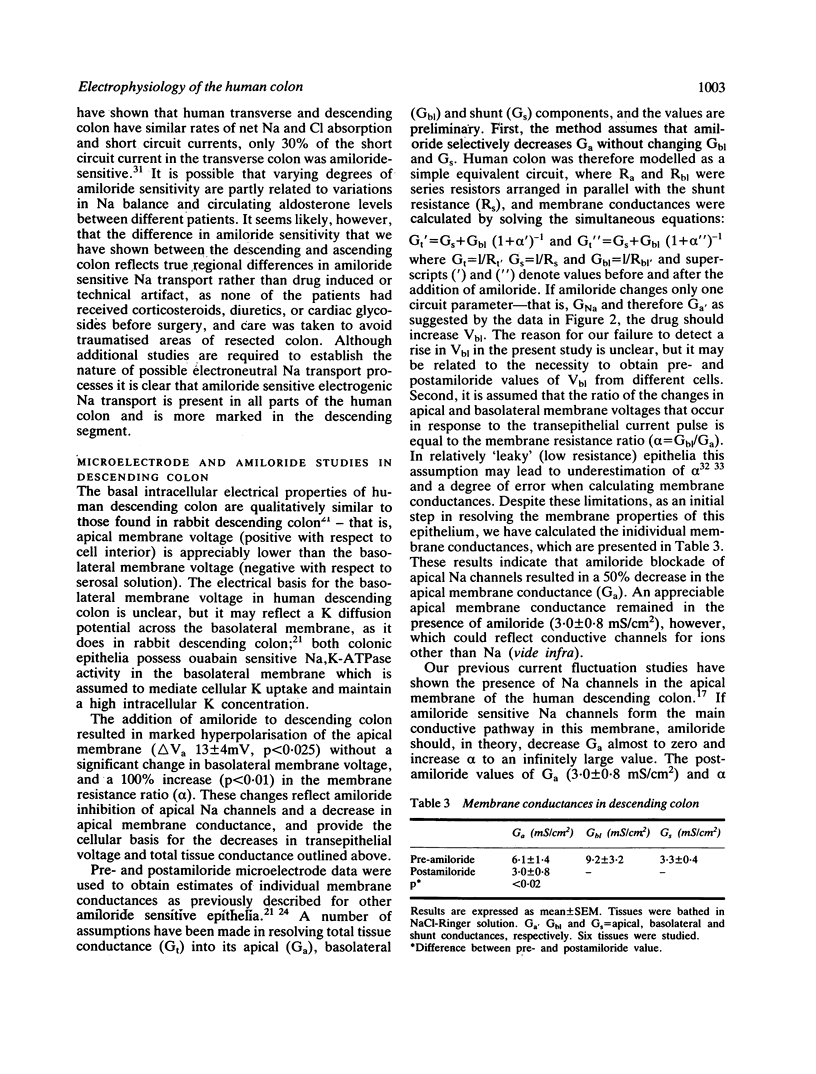
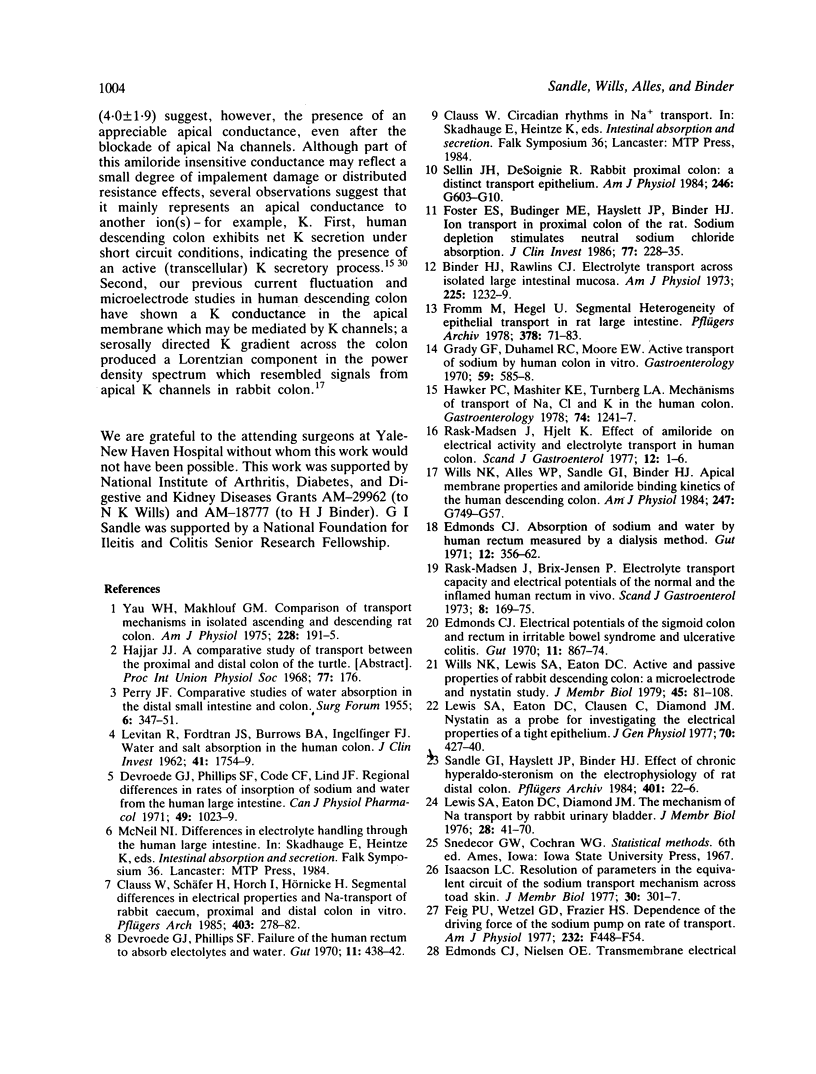

Selected References
These references are in PubMed. This may not be the complete list of references from this article.
- Archampong E. Q., Harris J., Clark C. G. The absorption and secretion of water and electrolytes across the healthy and the diseased human colonic mucosa measured in vitro. Gut. 1972 Nov;13(11):880–886. doi: 10.1136/gut.13.11.880. [DOI] [PMC free article] [PubMed] [Google Scholar]
- Binder H. J., Rawlins C. L. Electrolyte transport across isolated large intestinal mucosa. Am J Physiol. 1973 Nov;225(5):1232–1239. doi: 10.1152/ajplegacy.1973.225.5.1232. [DOI] [PubMed] [Google Scholar]
- Clausen C., Lewis S. A., Diamond J. M. Impedance analysis of a tight epithelium using a distributed resistance model. Biophys J. 1979 May;26(2):291–317. doi: 10.1016/S0006-3495(79)85250-9. [DOI] [PMC free article] [PubMed] [Google Scholar]
- Clauss W., Schäfer H., Horch I., Hörnicke H. Segmental differences in electrical properties and Na-transport of rabbit caecum, proximal and distal colon in vitro. Pflugers Arch. 1985 Mar;403(3):278–282. doi: 10.1007/BF00583600. [DOI] [PubMed] [Google Scholar]
- Devroede G. J., Phillips S. F., Code C. F., Lind J. F. Regional differences in rates of insorption of sodium and water from the human large intestine. Can J Physiol Pharmacol. 1971 Dec;49(12):1023–1029. doi: 10.1139/y71-145. [DOI] [PubMed] [Google Scholar]
- Devroede G. J., Phillips S. F. Failure of the human rectum to absorb electrolytes and water. Gut. 1970 May;11(5):438–442. doi: 10.1136/gut.11.5.438. [DOI] [PMC free article] [PubMed] [Google Scholar]
- Edmonds C. J. Absorption of sodium and water by human rectum measured by a dialysis method. Gut. 1971 May;12(5):356–362. doi: 10.1136/gut.12.5.356. [DOI] [PMC free article] [PubMed] [Google Scholar]
- Edmonds C. J. Electrical potentials of the sigmoid colon and rectum in irritable bowel syndrome and ulcerative colitis. Gut. 1970 Oct;11(10):867–874. doi: 10.1136/gut.11.10.867. [DOI] [PMC free article] [PubMed] [Google Scholar]
- Foster E. S., Budinger M. E., Hayslett J. P., Binder H. J. Ion transport in proximal colon of the rat. Sodium depletion stimulates neutral sodium chloride absorption. J Clin Invest. 1986 Jan;77(1):228–235. doi: 10.1172/JCI112281. [DOI] [PMC free article] [PubMed] [Google Scholar]
- Fromm M., Hegel U. Segmental heterogeneity of epithelial transport in rat large intestine. Pflugers Arch. 1978 Dec 15;378(1):71–83. doi: 10.1007/BF00581960. [DOI] [PubMed] [Google Scholar]
- Hawker P. C., Mashiter K. E., Turnberg L. A. Mechanisms of transport of Na, Cl, and K in the human colon. Gastroenterology. 1978 Jun;74(6):1241–1247. [PubMed] [Google Scholar]
- Isaacson L. C. Resolution of parameters in the equivalent electrical circuit of the sodium transport mechanism across toad skin. J Membr Biol. 1977 Jan 28;30(4):301–317. doi: 10.1007/BF01869674. [DOI] [PubMed] [Google Scholar]
- LEVITAN R., FORDTRAN J. S., BURROWS B. A., INGELFINGER F. J. Water and salt absorption in the human colon. J Clin Invest. 1962 Sep;41:1754–1759. doi: 10.1172/JCI104634. [DOI] [PMC free article] [PubMed] [Google Scholar]
- Lewis S. A., Eaton D. C., Clausen C., Diamond J. M. Nystatin as a probe for investigating the electrical properties of a tight epithelium. J Gen Physiol. 1977 Oct;70(4):427–440. doi: 10.1085/jgp.70.4.427. [DOI] [PMC free article] [PubMed] [Google Scholar]
- Lewis S. A., Eaton D. C., Diamond J. M. The mechanism of Na+ transport by rabbit urinary bladder. J Membr Biol. 1976 Aug 27;28(1):41–70. doi: 10.1007/BF01869690. [DOI] [PubMed] [Google Scholar]
- PERRY J. F., Jr Comparative studies of water absorption in the distal small intestine and colon. Surg Forum. 1956;6:347–351. [PubMed] [Google Scholar]
- Rask-Madsen J., Hjelt K. Effect of amiloride on electrical activity and electrolyte transport in human colon. Scand J Gastroenterol. 1977;12(1):1–6. [PubMed] [Google Scholar]
- Rask-Madsen J., Jensen P. B. Electrolyte transport capacity and electrical potentials of the normal and the inflamed human rectum in vivo. Scand J Gastroenterol. 1973;8(2):169–175. [PubMed] [Google Scholar]
- Sandle G. I., Hayslett J. P., Binder H. J. Effect of chronic hyperaldosteronism on the electrophysiology of rat distal colon. Pflugers Arch. 1984 May;401(1):22–26. doi: 10.1007/BF00581528. [DOI] [PubMed] [Google Scholar]
- Schultz S. G., Frizzell R. A., Nellans H. N. Active sodium transport and the electrophysiology of rabbit colon. J Membr Biol. 1977 May 12;33(3-4):351–384. doi: 10.1007/BF01869524. [DOI] [PubMed] [Google Scholar]
- Sellin J. H., DeSoignie R. Rabbit proximal colon: a distinct transport epithelium. Am J Physiol. 1984 May;246(5 Pt 1):G603–G610. doi: 10.1152/ajpgi.1984.246.5.G603. [DOI] [PubMed] [Google Scholar]
- Wills N. K., Alles W. P., Sandle G. I., Binder H. J. Apical membrane properties and amiloride binding kinetics of the human descending colon. Am J Physiol. 1984 Dec;247(6 Pt 1):G749–G757. doi: 10.1152/ajpgi.1984.247.6.G749. [DOI] [PubMed] [Google Scholar]
- Wills N. K., Lewis S. A., Eaton D. C. Active and passive properties of rabbit descending colon: a microelectrode and nystatin study. J Membr Biol. 1979 Mar 28;45(1-2):81–108. doi: 10.1007/BF01869296. [DOI] [PubMed] [Google Scholar]
- Yau W. M., Makhlouf G. M. Comparison of transport mechanisms in isolated ascending and descending rat colon. Am J Physiol. 1975 Jan;228(1):191–195. doi: 10.1152/ajplegacy.1975.228.1.191. [DOI] [PubMed] [Google Scholar]


